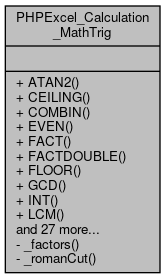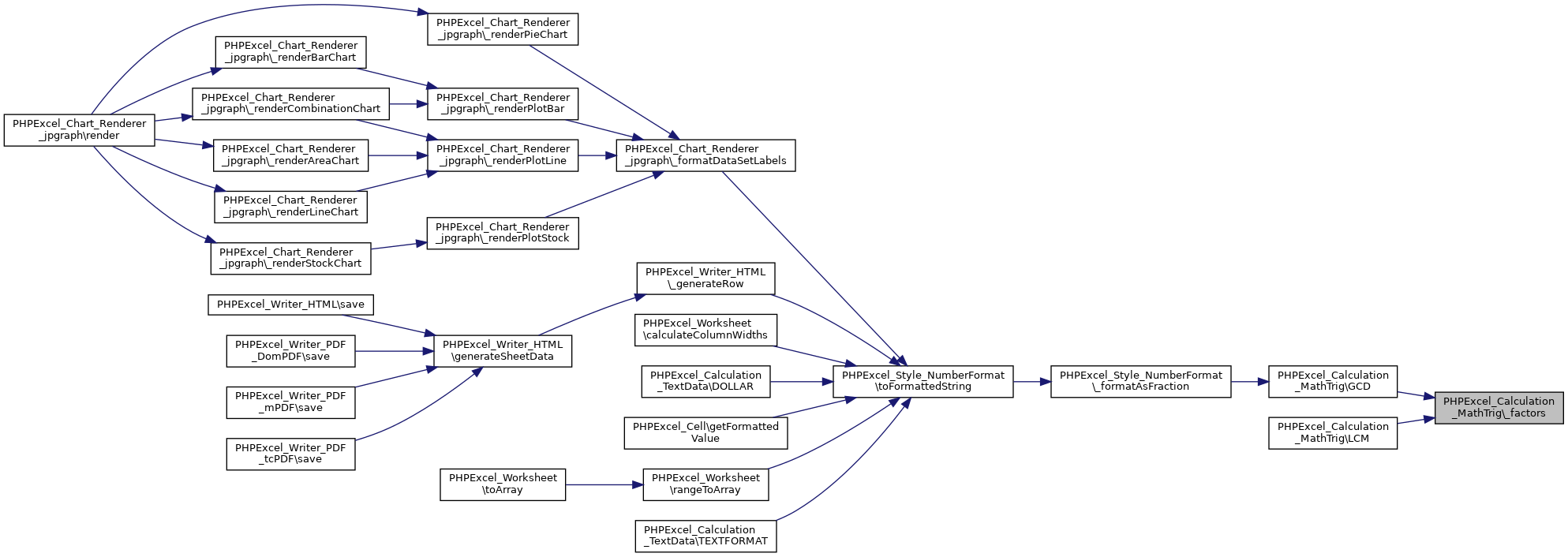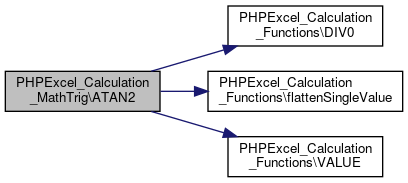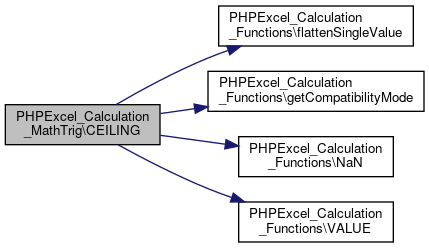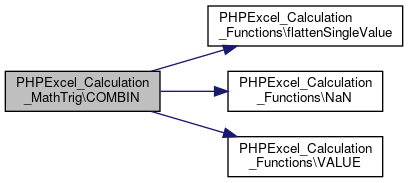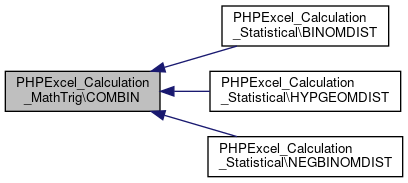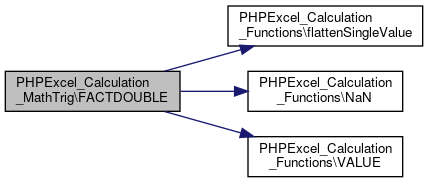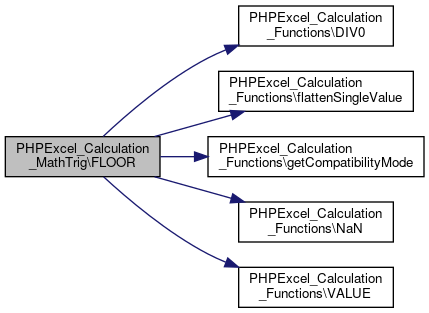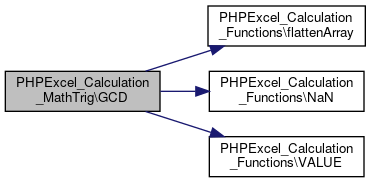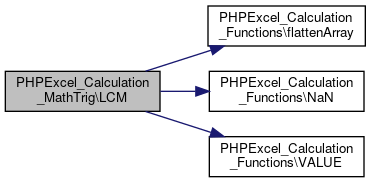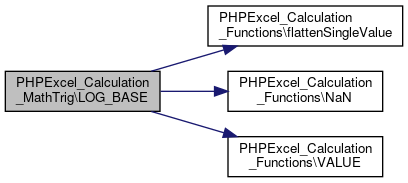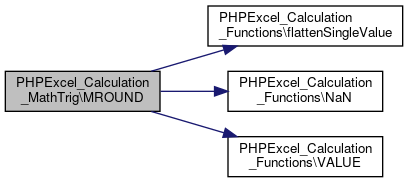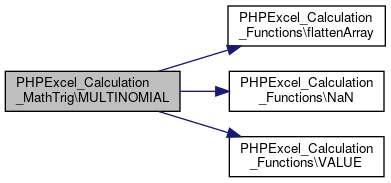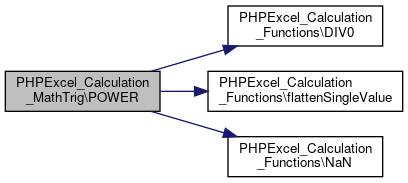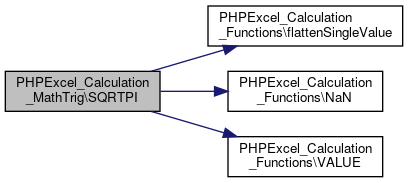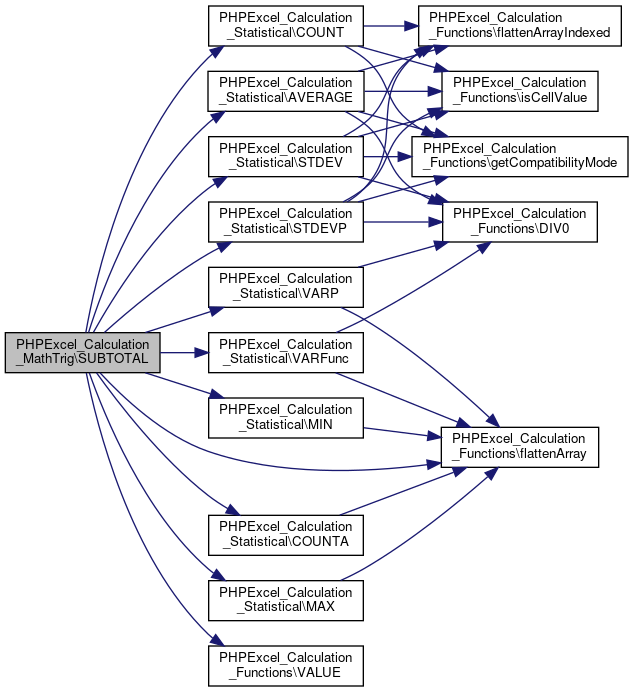 Collaboration diagram for PHPExcel_Calculation_MathTrig:
Collaboration diagram for PHPExcel_Calculation_MathTrig:Static Public Member Functions | |
| static | ATAN2 ($xCoordinate=NULL, $yCoordinate=NULL) |
| static | CEILING ($number, $significance=NULL) |
| static | COMBIN ($numObjs, $numInSet) |
| static | EVEN ($number) |
| static | FACT ($factVal) |
| static | FACTDOUBLE ($factVal) |
| static | FLOOR ($number, $significance=NULL) |
| static | GCD () |
| static | INT ($number) |
| static | LCM () |
| static | LOG_BASE ($number=NULL, $base=10) |
| static | MDETERM ($matrixValues) |
| static | MINVERSE ($matrixValues) |
| static | MMULT ($matrixData1, $matrixData2) |
| MMULT. More... | |
| static | MOD ($a=1, $b=1) |
| MOD. More... | |
| static | MROUND ($number, $multiple) |
| MROUND. More... | |
| static | MULTINOMIAL () |
| MULTINOMIAL. More... | |
| static | ODD ($number) |
| ODD. More... | |
| static | POWER ($x=0, $y=2) |
| POWER. More... | |
| static | PRODUCT () |
| static | QUOTIENT () |
| static | RAND ($min=0, $max=0) |
| RAND. More... | |
| static | ROMAN ($aValue, $style=0) |
| static | ROUNDUP ($number, $digits) |
| ROUNDUP. More... | |
| static | ROUNDDOWN ($number, $digits) |
| ROUNDDOWN. More... | |
| static | SERIESSUM () |
| SERIESSUM. More... | |
| static | SIGN ($number) |
| SIGN. More... | |
| static | SQRTPI ($number) |
| SQRTPI. More... | |
| static | SUBTOTAL () |
| SUBTOTAL. More... | |
| static | SUM () |
| static | SUMIF ($aArgs, $condition, $sumArgs=array()) |
| static | SUMPRODUCT () |
| static | SUMSQ () |
| static | SUMX2MY2 ($matrixData1, $matrixData2) |
| SUMX2MY2. More... | |
| static | SUMX2PY2 ($matrixData1, $matrixData2) |
| SUMX2PY2. More... | |
| static | SUMXMY2 ($matrixData1, $matrixData2) |
| SUMXMY2. More... | |
| static | TRUNC ($value=0, $digits=0) |
| TRUNC. More... | |
Static Private Member Functions | |
| static | _factors ($value) |
| static | _romanCut ($num, $n) |
Detailed Description
Definition at line 46 of file MathTrig.php.
Member Function Documentation
◆ _factors()
|
staticprivate |
Definition at line 51 of file MathTrig.php.
Referenced by GCD(), and LCM().
 Here is the caller graph for this function:
Here is the caller graph for this function:◆ _romanCut()
|
staticprivate |
Definition at line 73 of file MathTrig.php.
References $n.
Referenced by ROMAN().
 Here is the caller graph for this function:
Here is the caller graph for this function:◆ ATAN2()
|
static |
Definition at line 100 of file MathTrig.php.
References PHPExcel_Calculation_Functions\DIV0(), PHPExcel_Calculation_Functions\flattenSingleValue(), and PHPExcel_Calculation_Functions\VALUE().
 Here is the call graph for this function:
Here is the call graph for this function:◆ CEILING()
|
static |
Definition at line 139 of file MathTrig.php.
References PHPExcel_Calculation_Functions\COMPATIBILITY_GNUMERIC, PHPExcel_Calculation_Functions\flattenSingleValue(), PHPExcel_Calculation_Functions\getCompatibilityMode(), PHPExcel_Calculation_Functions\NaN(), and PHPExcel_Calculation_Functions\VALUE().
Referenced by EVEN(), and ODD().
 Here is the call graph for this function:
Here is the call graph for this function: Here is the caller graph for this function:
Here is the caller graph for this function:◆ COMBIN()
|
static |
Definition at line 176 of file MathTrig.php.
References FACT(), PHPExcel_Calculation_Functions\flattenSingleValue(), PHPExcel_Calculation_Functions\NaN(), and PHPExcel_Calculation_Functions\VALUE().
Referenced by PHPExcel_Calculation_Statistical\BINOMDIST(), PHPExcel_Calculation_Statistical\HYPGEOMDIST(), and PHPExcel_Calculation_Statistical\NEGBINOMDIST().
 Here is the call graph for this function:
Here is the call graph for this function: Here is the caller graph for this function:
Here is the caller graph for this function:◆ EVEN()
|
static |
Definition at line 209 of file MathTrig.php.
References CEILING(), PHPExcel_Calculation_Functions\flattenSingleValue(), SIGN(), and PHPExcel_Calculation_Functions\VALUE().
 Here is the call graph for this function:
Here is the call graph for this function:◆ FACT()
|
static |
Definition at line 240 of file MathTrig.php.
References PHPExcel_Calculation_Functions\COMPATIBILITY_GNUMERIC, PHPExcel_Calculation_Functions\flattenSingleValue(), PHPExcel_Calculation_Functions\getCompatibilityMode(), PHPExcel_Calculation_Functions\NaN(), and PHPExcel_Calculation_Functions\VALUE().
Referenced by PHPExcel_Calculation_Engineering\BESSELI(), PHPExcel_Calculation_Engineering\BESSELJ(), COMBIN(), MULTINOMIAL(), PHPExcel_Calculation_Statistical\PERMUT(), and PHPExcel_Calculation_Statistical\POISSON().
 Here is the call graph for this function:
Here is the call graph for this function: Here is the caller graph for this function:
Here is the caller graph for this function:◆ FACTDOUBLE()
|
static |
Definition at line 277 of file MathTrig.php.
References PHPExcel_Calculation_Functions\flattenSingleValue(), PHPExcel_Calculation_Functions\NaN(), and PHPExcel_Calculation_Functions\VALUE().
 Here is the call graph for this function:
Here is the call graph for this function:◆ FLOOR()
|
static |
Definition at line 310 of file MathTrig.php.
References PHPExcel_Calculation_Functions\COMPATIBILITY_GNUMERIC, PHPExcel_Calculation_Functions\DIV0(), PHPExcel_Calculation_Functions\flattenSingleValue(), PHPExcel_Calculation_Functions\getCompatibilityMode(), PHPExcel_Calculation_Functions\NaN(), and PHPExcel_Calculation_Functions\VALUE().
 Here is the call graph for this function:
Here is the call graph for this function:◆ GCD()
|
static |
Definition at line 349 of file MathTrig.php.
References _factors(), PHPExcel_Calculation_Functions\flattenArray(), PHPExcel_Calculation_Functions\NaN(), and PHPExcel_Calculation_Functions\VALUE().
Referenced by PHPExcel_Style_NumberFormat\_formatAsFraction().
 Here is the call graph for this function:
Here is the call graph for this function: Here is the caller graph for this function:
Here is the caller graph for this function:◆ INT()
|
static |
Definition at line 423 of file MathTrig.php.
References PHPExcel_Calculation_Functions\flattenSingleValue(), and PHPExcel_Calculation_Functions\VALUE().
 Here is the call graph for this function:
Here is the call graph for this function:◆ LCM()
|
static |
Definition at line 454 of file MathTrig.php.
References _factors(), PHPExcel_Calculation_Functions\flattenArray(), PHPExcel_Calculation_Functions\NaN(), and PHPExcel_Calculation_Functions\VALUE().
 Here is the call graph for this function:
Here is the call graph for this function:◆ LOG_BASE()
|
static |
Definition at line 504 of file MathTrig.php.
References PHPExcel_Calculation_Functions\flattenSingleValue(), PHPExcel_Calculation_Functions\NaN(), and PHPExcel_Calculation_Functions\VALUE().
 Here is the call graph for this function:
Here is the call graph for this function:◆ MDETERM()
|
static |
Definition at line 529 of file MathTrig.php.
References $column, $row, and PHPExcel_Calculation_Functions\VALUE().
 Here is the call graph for this function:
Here is the call graph for this function:◆ MINVERSE()
|
static |
Definition at line 571 of file MathTrig.php.
References $column, $row, and PHPExcel_Calculation_Functions\VALUE().
 Here is the call graph for this function:
Here is the call graph for this function:◆ MMULT()
|
static |
MMULT.
- Parameters
-
array $matrixData1 A matrix of values array $matrixData2 A matrix of values
- Returns
- array
Definition at line 607 of file MathTrig.php.
References PHPExcel_Calculation_Functions\VALUE().
 Here is the call graph for this function:
Here is the call graph for this function:◆ MOD()
|
static |
MOD.
- Parameters
-
int $a Dividend int $b Divisor
- Returns
- int Remainder
Definition at line 661 of file MathTrig.php.
References PHPExcel_Calculation_Functions\DIV0(), and PHPExcel_Calculation_Functions\flattenSingleValue().
 Here is the call graph for this function:
Here is the call graph for this function:◆ MROUND()
|
static |
MROUND.
Rounds a number to the nearest multiple of a specified value
- Parameters
-
float $number Number to round int $multiple Multiple to which you want to round $number
- Returns
- float Rounded Number
Definition at line 686 of file MathTrig.php.
References PHPExcel_Calculation_Functions\flattenSingleValue(), PHPExcel_Calculation_Functions\NaN(), and PHPExcel_Calculation_Functions\VALUE().
Referenced by PHPExcel_Calculation_TextData\DOLLAR().
 Here is the call graph for this function:
Here is the call graph for this function: Here is the caller graph for this function:
Here is the caller graph for this function:◆ MULTINOMIAL()
|
static |
MULTINOMIAL.
Returns the ratio of the factorial of a sum of values to the product of factorials.
- Parameters
-
array of mixed Data Series
- Returns
- float
Definition at line 712 of file MathTrig.php.
References FACT(), PHPExcel_Calculation_Functions\flattenArray(), PHPExcel_Calculation_Functions\NaN(), and PHPExcel_Calculation_Functions\VALUE().
 Here is the call graph for this function:
Here is the call graph for this function:◆ ODD()
|
static |
ODD.
Returns number rounded up to the nearest odd integer.
- Parameters
-
float $number Number to round
- Returns
- int Rounded Number
Definition at line 746 of file MathTrig.php.
References $result, CEILING(), PHPExcel_Calculation_Functions\flattenSingleValue(), SIGN(), and PHPExcel_Calculation_Functions\VALUE().
 Here is the call graph for this function:
Here is the call graph for this function:◆ POWER()
|
static |
POWER.
Computes x raised to the power y.
- Parameters
-
float $x float $y
- Returns
- float
Definition at line 781 of file MathTrig.php.
References $result, $x, $y, PHPExcel_Calculation_Functions\DIV0(), PHPExcel_Calculation_Functions\flattenSingleValue(), and PHPExcel_Calculation_Functions\NaN().
 Here is the call graph for this function:
Here is the call graph for this function:◆ PRODUCT()
|
static |
Definition at line 811 of file MathTrig.php.
References PHPExcel_Calculation_Functions\flattenArray().
Referenced by PHPExcel_Calculation_Database\DPRODUCT(), PHPExcel_Calculation_Statistical\GEOMEAN(), and SUBTOTAL().
 Here is the call graph for this function:
Here is the call graph for this function: Here is the caller graph for this function:
Here is the caller graph for this function:◆ QUOTIENT()
|
static |
Definition at line 849 of file MathTrig.php.
References PHPExcel_Calculation_Functions\flattenArray().
 Here is the call graph for this function:
Here is the call graph for this function:◆ RAND()
|
static |
RAND.
- Parameters
-
int $min Minimal value int $max Maximal value
- Returns
- int Random number
Definition at line 881 of file MathTrig.php.
References PHPExcel_Calculation_Functions\flattenSingleValue().
 Here is the call graph for this function:
Here is the call graph for this function:◆ ROMAN()
|
static |
Definition at line 893 of file MathTrig.php.
References $style, $t, _romanCut(), PHPExcel_Calculation_Functions\flattenSingleValue(), and PHPExcel_Calculation_Functions\VALUE().
 Here is the call graph for this function:
Here is the call graph for this function:◆ ROUNDDOWN()
|
static |
ROUNDDOWN.
Rounds a number down to a specified number of decimal places
- Parameters
-
float $number Number to round int $digits Number of digits to which you want to round $number
- Returns
- float Rounded Number
Definition at line 956 of file MathTrig.php.
References PHPExcel_Calculation_Functions\flattenSingleValue(), and PHPExcel_Calculation_Functions\VALUE().
 Here is the call graph for this function:
Here is the call graph for this function:◆ ROUNDUP()
|
static |
ROUNDUP.
Rounds a number up to a specified number of decimal places
- Parameters
-
float $number Number to round int $digits Number of digits to which you want to round $number
- Returns
- float Rounded Number
Definition at line 931 of file MathTrig.php.
References PHPExcel_Calculation_Functions\flattenSingleValue(), and PHPExcel_Calculation_Functions\VALUE().
 Here is the call graph for this function:
Here is the call graph for this function:◆ SERIESSUM()
|
static |
SERIESSUM.
Returns the sum of a power series
- Parameters
-
float $x Input value to the power series float $n Initial power to which you want to raise $x float $m Step by which to increase $n for each term in the series array of mixed Data Series
- Returns
- float
Definition at line 983 of file MathTrig.php.
References $n, $x, PHPExcel_Calculation_Functions\flattenArray(), and PHPExcel_Calculation_Functions\VALUE().
 Here is the call graph for this function:
Here is the call graph for this function:◆ SIGN()
|
static |
SIGN.
Determines the sign of a number. Returns 1 if the number is positive, zero (0) if the number is 0, and -1 if the number is negative.
- Parameters
-
float $number Number to round
- Returns
- int sign value
Definition at line 1021 of file MathTrig.php.
References PHPExcel_Calculation_Functions\flattenSingleValue(), and PHPExcel_Calculation_Functions\VALUE().
Referenced by EVEN(), and ODD().
 Here is the call graph for this function:
Here is the call graph for this function: Here is the caller graph for this function:
Here is the caller graph for this function:◆ SQRTPI()
|
static |
SQRTPI.
Returns the square root of (number * pi).
- Parameters
-
float $number Number
- Returns
- float Square Root of Number * Pi
Definition at line 1044 of file MathTrig.php.
References PHPExcel_Calculation_Functions\flattenSingleValue(), PHPExcel_Calculation_Functions\NaN(), and PHPExcel_Calculation_Functions\VALUE().
 Here is the call graph for this function:
Here is the call graph for this function:◆ SUBTOTAL()
|
static |
SUBTOTAL.
Returns a subtotal in a list or database.
- Parameters
-
int the number 1 to 11 that specifies which function to use in calculating subtotals within a list. array of mixed Data Series
- Returns
- float
Definition at line 1067 of file MathTrig.php.
References PHPExcel_Calculation_Statistical\AVERAGE(), PHPExcel_Calculation_Statistical\COUNT(), PHPExcel_Calculation_Statistical\COUNTA(), PHPExcel_Calculation_Functions\flattenArray(), PHPExcel_Calculation_Statistical\MAX(), PHPExcel_Calculation_Statistical\MIN(), PRODUCT(), PHPExcel_Calculation_Statistical\STDEV(), PHPExcel_Calculation_Statistical\STDEVP(), SUM(), PHPExcel_Calculation_Functions\VALUE(), PHPExcel_Calculation_Statistical\VARFunc(), and PHPExcel_Calculation_Statistical\VARP().
 Here is the call graph for this function:
Here is the call graph for this function:◆ SUM()
|
static |
Definition at line 1127 of file MathTrig.php.
References PHPExcel_Calculation_Functions\flattenArray().
Referenced by PHPExcel_Calculation_Database\DSUM(), and SUBTOTAL().
 Here is the call graph for this function:
Here is the call graph for this function: Here is the caller graph for this function:
Here is the caller graph for this function:◆ SUMIF()
|
static |
Definition at line 1158 of file MathTrig.php.
References PHPExcel_Calculation_Functions\_ifCondition(), PHPExcel_Calculation\_wrapResult(), PHPExcel_Calculation_Functions\flattenArray(), and PHPExcel_Calculation\getInstance().
 Here is the call graph for this function:
Here is the call graph for this function:◆ SUMPRODUCT()
|
static |
Definition at line 1198 of file MathTrig.php.
References PHPExcel_Calculation_Functions\flattenArray(), and PHPExcel_Calculation_Functions\VALUE().
 Here is the call graph for this function:
Here is the call graph for this function:◆ SUMSQ()
|
static |
Definition at line 1242 of file MathTrig.php.
References PHPExcel_Calculation_Functions\flattenArray().
 Here is the call graph for this function:
Here is the call graph for this function:◆ SUMX2MY2()
|
static |
SUMX2MY2.
- Parameters
-
mixed[] $matrixData1 Matrix #1 mixed[] $matrixData2 Matrix #2
- Returns
- float
Definition at line 1266 of file MathTrig.php.
References $result, and PHPExcel_Calculation_Functions\flattenArray().
 Here is the call graph for this function:
Here is the call graph for this function:◆ SUMX2PY2()
|
static |
SUMX2PY2.
- Parameters
-
mixed[] $matrixData1 Matrix #1 mixed[] $matrixData2 Matrix #2
- Returns
- float
Definition at line 1296 of file MathTrig.php.
References $result, and PHPExcel_Calculation_Functions\flattenArray().
 Here is the call graph for this function:
Here is the call graph for this function:◆ SUMXMY2()
|
static |
SUMXMY2.
- Parameters
-
mixed[] $matrixData1 Matrix #1 mixed[] $matrixData2 Matrix #2
- Returns
- float
Definition at line 1326 of file MathTrig.php.
References $result, and PHPExcel_Calculation_Functions\flattenArray().
 Here is the call graph for this function:
Here is the call graph for this function:◆ TRUNC()
|
static |
TRUNC.
Truncates value to the number of fractional digits by number_digits.
- Parameters
-
float $value int $digits
- Returns
- float Truncated value
Definition at line 1358 of file MathTrig.php.
References PHPExcel_Calculation_Functions\flattenSingleValue(), and PHPExcel_Calculation_Functions\VALUE().
 Here is the call graph for this function:
Here is the call graph for this function:The documentation for this class was generated from the following file:
- libs/composer/vendor/phpoffice/phpexcel/Classes/PHPExcel/Calculation/MathTrig.php
